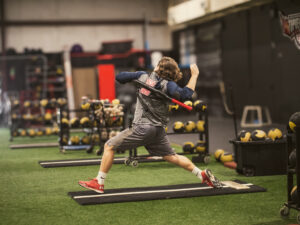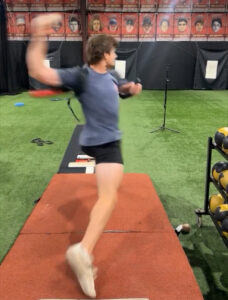 In the world of sports training, technology is advancing rapidly, and one of the most innovative tools making its way into athletic programs is the exo-skeleton device. Designed to support, guide, and enhance body movements, these devices are transforming how athletes learn and perfect their mechanics. In baseball, where precision and power are crucial, exo-skeletons are being used to help pitchers master proper form, improve muscle memory, and reduce the risk of injury. This article explores how exo-skeleton technology works, its specific benefits for baseball pitchers, and why it may soon become a staple in sports training programs. By providing direct feedback and reinforcing correct movement patterns, exo-skeleton devices are setting a new standard for training efficiency and effectiveness.
In the world of sports training, technology is advancing rapidly, and one of the most innovative tools making its way into athletic programs is the exo-skeleton device. Designed to support, guide, and enhance body movements, these devices are transforming how athletes learn and perfect their mechanics. In baseball, where precision and power are crucial, exo-skeletons are being used to help pitchers master proper form, improve muscle memory, and reduce the risk of injury. This article explores how exo-skeleton technology works, its specific benefits for baseball pitchers, and why it may soon become a staple in sports training programs. By providing direct feedback and reinforcing correct movement patterns, exo-skeleton devices are setting a new standard for training efficiency and effectiveness.
To integrate the findings from this study into the article, we can highlight how exo-skeleton devices, like the Trunk Excelerator, support the development of key mechanics for improving pitching velocity. Here’s an updated section incorporating the study’s insights:
How Are Exo-Skeleton Devices Beneficial in Sports?
 Exo-skeleton devices offer groundbreaking benefits to athletes by enhancing body mechanics, building muscle memory, and promoting injury prevention. These wearable systems guide athletes through correct movement patterns, reinforcing proper form with real-time feedback. In sports like baseball, where precise mechanics are essential, exo-skeletons allow athletes to repeatedly practice optimized motions. For pitchers, devices like the Trunk Excelerator support the development of critical movements such as hip-to-shoulder separation and controlled trunk rotation—key elements for maximizing pitch velocity and control.
Exo-skeleton devices offer groundbreaking benefits to athletes by enhancing body mechanics, building muscle memory, and promoting injury prevention. These wearable systems guide athletes through correct movement patterns, reinforcing proper form with real-time feedback. In sports like baseball, where precise mechanics are essential, exo-skeletons allow athletes to repeatedly practice optimized motions. For pitchers, devices like the Trunk Excelerator support the development of critical movements such as hip-to-shoulder separation and controlled trunk rotation—key elements for maximizing pitch velocity and control.
Research published in the *Journal of Applied Biomechanics* by Luera, Dowling, Muddle, and Jenkins highlights the relationship between trunk rotation and pitch velocity, showing that higher-velocity pitchers achieve greater upper trunk rotation and generate higher angular velocities. According to the study, professional pitchers throwing at higher velocities exhibited a significant increase in upper trunk rotation during hand separation and elbow extension, as well as greater trunk angular velocities overall. These findings emphasize the importance of proper trunk rotation and its timing in the pitching motion, which can directly influence pitch speed.
Exo-skeleton devices like the Trunk Excelerator align with these findings by helping pitchers experience and internalize the exact trunk positioning needed for increased velocity. By stabilizing the trunk in a slightly rotated position, exo-skeletons allow pitchers to focus on increasing rotational power without straining their upper body. This guided practice promotes the neuromuscular coordination necessary to achieve optimal trunk rotation and timing, helping athletes reach their velocity potential while reducing injury risk.
Exo-Skeleton Devices: Developing Optimal Hip-to-shoulder Separation in Pitchers
Exo-skeleton devices offer a unique approach to training that can significantly aid baseball pitchers in developing effective hip-to-shoulder separation. This aspect of biomechanics is critical for generating velocity and reducing strain on the arm. Studies, such as those conducted by Albiero et al., have shown that hip strength directly influences pitching biomechanics, particularly in producing the hip-to-shoulder separation needed for high-performance throws. By training pitchers to achieve this separation through guided support and feedback, exo-skeleton devices help athletes internalize the correct positioning, allowing them to consistently engage their trunk and lower body more effectively during their delivery.
The importance of hip-to-shoulder separation lies in its ability to harness energy generated from the lower body and efficiently transfer it through the kinetic chain. Exo-skeleton devices stabilize the athlete’s trunk while promoting the rotation of the hips and shoulders in the correct sequence. This support enables pitchers to feel the difference between ideal and suboptimal positioning, reinforcing proper rotation patterns that protect the shoulder and elbow joints. Albiero et al.’s findings highlight that stronger hip rotation, especially at points like maximum shoulder external rotation, correlates with reduced elbow and shoulder stress, underscoring how targeted hip-to-shoulder separation can prevent injuries.
Moreover, these devices help address specific limitations in hip strength and mobility, which are often barriers to achieving ideal separation. According to the study, back hip extension strength showed a significant relationship with hip-to-shoulder separation, indicating that weaknesses in the hips can negatively impact trunk rotation and overall throwing efficiency. Exo-skeleton devices allow athletes to train around these limitations by stabilizing weaker areas and gradually improving strength and flexibility, making it easier for pitchers to reach and maintain optimal separation as they progress.
By integrating exo-skeleton devices into training, pitchers can not only develop better hip-to-shoulder separation but also reinforce the motor coordination necessary to sustain it under game conditions. These devices provide instant feedback that helps athletes feel the precise alignment needed to achieve maximum rotational force, leading to more powerful and controlled pitches. With evidence linking hip strength to improved biomechanics and reduced injury risk, exo-skeleton devices serve as a valuable tool in helping athletes master the complex interplay of movements essential for high-performance pitching.
Exo-Skeleton Devices vs. Traditional Training: What’s the Difference?
While traditional training drills and coaching have long been the foundation of baseball pitching development, exo-skeleton devices bring an innovative approach that offers benefits beyond conventional methods. Traditional pitching drills focus on repetition and technique refinement through verbal feedback, visual cues, and corrective exercises. While effective, these methods often rely heavily on the athlete's ability to internalize feedback and make adjustments. Exo-skeleton devices, on the other hand, use physical support and real-time feedback to guide the body into proper positions, giving athletes an immediate, physical sense of correct mechanics. This difference can be especially valuable for athletes struggling to grasp or repeat complex movements like hip-to-shoulder separation and optimal trunk rotation.
One of the major advantages of exo-skeleton training is its ability to offer *proprioceptive feedback*—feedback that helps athletes physically feel the correct positions and movements. With traditional coaching, athletes may understand what they need to do but lack the physical awareness to consistently replicate those mechanics. Exo-skeletons create structured resistance and support around key areas, helping the pitcher feel the correct movement patterns in real time. This kind of “hands-on” guidance promotes faster neuromuscular learning, which can be particularly beneficial for developing the intricate sequences of hip rotation, trunk alignment, and shoulder engagement essential to powerful and efficient pitching.
Furthermore, exo-skeleton devices can reduce the risk of overuse and strain by offering additional stability during training. Traditional training sometimes leads to overuse injuries, as players repeat the same movements before they have developed the foundational strength and stability needed to perform them safely. Exo-skeletons provide targeted support, allowing athletes to focus on mechanics and gradually increase strength in a controlled way, reducing stress on vulnerable joints like the shoulder and elbow. This is particularly advantageous for younger or developing players who may lack the muscle endurance required for the demands of high-volume traditional drills.
In essence, exo-skeletons complement traditional training by accelerating the development of correct biomechanics and building strength safely. While they don’t replace the insights of a skilled coach or the benefits of foundational pitching drills, exo-skeletons add an extra layer of precision and support that enhances the learning experience. By bridging the gap between theory and physical experience, exo-skeleton devices offer athletes a more dynamic, immersive approach to mastering proper pitching mechanics, making them a powerful addition to modern pitching programs.
Implementing Exo-Skeleton Training in a Pitching Program
Integrating exo-skeleton training into a pitching program can provide athletes with powerful, hands-on guidance to master their mechanics more effectively. Coaches can start by incorporating exo-skeleton sessions into a structured training routine, focusing on specific areas of improvement, such as hip-to-shoulder separation, trunk stability, and proper follow-through. Using exo-skeleton devices at the beginning of a training session as part of warm-up drills allows pitchers to set their bodies in the correct positions before progressing to traditional drills. This setup reinforces muscle memory and primes the neuromuscular system, so athletes are better prepared to translate these movements in full-speed practice.
Athletes can also benefit from incorporating exo-skeleton devices during strength and conditioning sessions, using them to perform movement-based strength drills like rotational exercises or hip and trunk stability work. This integration aligns with the 3X Pitching Methodology, which emphasizes the role of biomechanics, strength, and mobility in optimizing pitching performance. By using exo-skeleton devices alongside traditional conditioning, athletes build strength within the correct mechanics, reinforcing their body’s ability to maintain form even under physical fatigue.
To get the most out of exo-skeleton training, coaches can pair these devices with video analysis and biomechanical feedback to give athletes a comprehensive understanding of their movements. For example, after using an exo-skeleton to reinforce hip rotation and trunk alignment, pitchers can watch a video replay of their movement to visualize the impact. This feedback loop enables athletes to connect how correct positioning feels with how it looks in action, fostering quicker, more precise adjustments.
Closing Thoughts: Unleashing Your Potential with the 3X Pitching Velocity Camp and Exo-Skeleton Training
Exo-skeleton devices offer a revolutionary way for pitchers to achieve more consistent, powerful mechanics while reducing injury risks. By combining the science-backed 3X Pitching Methodology with exo-skeleton devices athletes can become a dominate force on the mound. If you want access to all the latest exo-skeleton devices and tools to enhance your pitching mechanics and speed up your motor learning process. Then you need to check out the Top Velocity 3x Pitching Velocity camp, where you can take advantage of all the latest scientific research and most advanced biomechanics analysis available. Embrace this innovative approach to pitching, and experience firsthand how these advancements can elevate your game. Click "try it now" below to view the details about our 3x-pitching velocity camp evaluation process and access the only curriculum you will need for the remainder of your career. 12-month financing options are available to qualifying participants. If you would like more information on registering for a payment plan option, please call us at 415-877-4850.
 Exo Skeleton Device for Optimal Trunk Coordination
Exo Skeleton Device for Optimal Trunk Coordination 
Already attended a 3X Velocity Camp but looking to purchase the Trunk Excelerator to continue honing your pitching mechanics at home? Click here to purchase your Trunk Excelerator.



 Exo Skeleton Device for Optimal Trunk Coordination
Exo Skeleton Device for Optimal Trunk Coordination 
